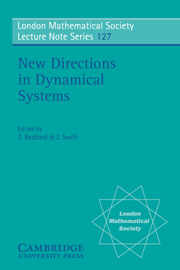Book contents
- Frontmatter
- Contents
- Preface
- Introduction
- Universality and Renormalisation in Dynamical Systems
- Smooth Dynamics on the Interval (with an emphasis on quadratic-like maps)
- Global Bifurcations in Flows
- Knots and Orbit Genealogies in Nonlinear Oscillators
- Limit Cycles of Polynomial Systems – Some Recent Developments
- Bifurcations with Symmetry
Smooth Dynamics on the Interval (with an emphasis on quadratic-like maps)
Published online by Cambridge University Press: 23 December 2009
- Frontmatter
- Contents
- Preface
- Introduction
- Universality and Renormalisation in Dynamical Systems
- Smooth Dynamics on the Interval (with an emphasis on quadratic-like maps)
- Global Bifurcations in Flows
- Knots and Orbit Genealogies in Nonlinear Oscillators
- Limit Cycles of Polynomial Systems – Some Recent Developments
- Bifurcations with Symmetry
Summary
There are many motivations for studying maps of the interval. Take for example maps from the quadratic family fμ(χ)=(μ-l) - μχ2. Mathematically these maps are very interesting because they can have such complicated, and yet quite well understood, dynamics. (The same can be said for the family of tent-maps X → 1 - μ|X|, but these are much simpler because of their linearity.) Already in the beginning of this century, Fatou and Julia observed that quadratic maps can have an infinite number of periodic points. Later, in the 1940's, Ulam and von Neumann observed that for μ=2 the map fμ has an absolutely continuous invariant measure. This implies that typical orbits of this map have stochastic behaviour. In the late 1950's P.J. Myrberg began to study quadratic maps, partly numerically. And in the 1960's, W.Parry and A.N. Sarkovskii began to describe the symbolic dynamics of these maps. Moreover A. Schwartz (1963) developed a tool which can be used to get metric results (bounded distortion results) for maps without “critical points”. For a more physical motivation for studying these maps see the book of P. Collet and J.P. Eckmann (1980).
In the 1970's the theory of these maps became much more mature. A much more complete understanding of the symbolic dynamics became possible through the work of M. Metropolis & M i. Stein & P.R. Stein (1973) and especially through J. Milnor & W. Thurston's (1977) preprint. In this last paper the kneading theory was developed.
- Type
- Chapter
- Information
- New Directions in Dynamical Systems , pp. 57 - 119Publisher: Cambridge University PressPrint publication year: 1988
- 8
- Cited by



